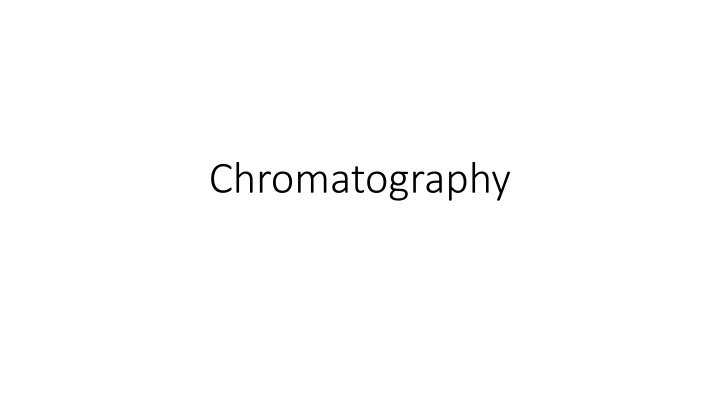
Chromatography: Separation Technique Overview
Learn about the history, importance, principles, and classifications of chromatography. Discover how this technique is used in various scientific fields, such as chemistry and biology, to separate and identify components within mixtures. Explore different types like liquid chromatography and gas chromatography, along with classification based on the mobile and stationary phases.
Download Presentation

Please find below an Image/Link to download the presentation.
The content on the website is provided AS IS for your information and personal use only. It may not be sold, licensed, or shared on other websites without obtaining consent from the author. If you encounter any issues during the download, it is possible that the publisher has removed the file from their server.
You are allowed to download the files provided on this website for personal or commercial use, subject to the condition that they are used lawfully. All files are the property of their respective owners.
The content on the website is provided AS IS for your information and personal use only. It may not be sold, licensed, or shared on other websites without obtaining consent from the author.
E N D
Presentation Transcript
History Mikhail Tswett, Russian, 1872-1919 Botanist In 1906 Tswett used to chromatography to separate plant pigments He called the new technique chromatography because the result of the analysis was 'written in color' along the length of the adsorbent column Chroma means color and graphein means to write
Importance Chromatography has application in every branch of the physical and biological sciences 12 Nobel prizes were awarded between 1937 and 1972 alone for work in which chromatography played a vital role
Chromatography is a physical method of separation in which the components to be separated are distributed between two phases one of which is stationary (stationary phase) while the other (the mobile phase) moves through it in a definite direction. The chromatographic process occurs due to differences in the distribution constant of the individual sample components.
Chromatography Is a technique used to separate and identify the components of a mixture. Works by allowing the molecules present in the mixture to distribute themselves between a stationary and a mobile medium. Molecules that spend most of their time in the mobile phase are carried along faster.
Classification of chromatography according to mobile phase: 1- Liquid chromatography: mobile phase is a liquid. (LLC, LSC). 2- Gas chromatography : mobile phase is a gas. (GSC, GLC).
Classification according to the packing of the stationary phase: 1- Thin layer chromatography (TLC): the stationary phase is a thin layer supported on glass, plastic or aluminium plates. 2- Paper chromatography (PC): the stationary phase is a thin film of liquid supported on an inert support. 3- Column chromatography (CC): stationary phase is packed in a glass column.
Plastic TLC Sheets Aluminum TLC Sheets















